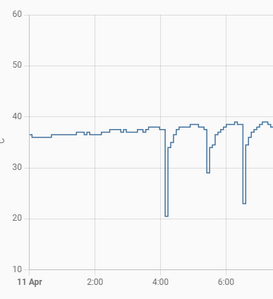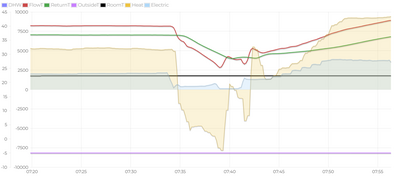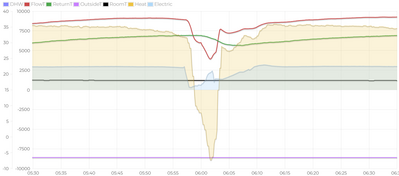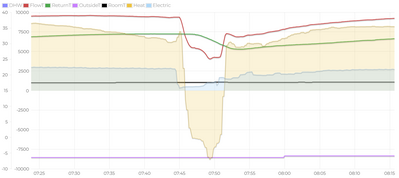In the middle of an ASHP installation - a few questions (and issues)
@jamespa - how is that the Vaillant data-logging is showing a COP below 1.0 on occasions?
Separately... Do any of these manufacturer's data-logs show when the ASHP was operating in defrosting mode?
That information is required by NESO and the DNOs because it's needed to plan where grid upgrades are required.
Unlike other forms of demand-surge, all ASHPs within the same area are likely to enter defrost mode together.
Save energy... recycle electrons!
@jamespa they didn't provide any contract, or design proposals. I had to ask what the design temp was and scop, and they just replied to the email. The only thing they did provide which was vaguely approaching a contract was the invoice that laid out the payment terms at the bottom.
I knew they were operating fast and loose, shall we say, but trusted them up to the point where it became clear that they had a strong propensity for dishonesty during the installation process and the various things they tried to get away with doing, or not doing.
The way you lay it out is pretty much exactly how I feel and how I have worded my grievance to them. It is working 'mostly' as intended. If they came to us from the start and said they could shave a couple of design degrees off what everyone else was proposing i.e. 47/48, there would be no issue really. I'll have a further think about reconciliation and what you say about what might be reasonable, is useful.
Strange no contract as it protects them more than it protects you IMHO, ie the absence of a contract puts you in a stronger position.
Perhaps, in addition to the above, give some thought to (a) what would put you 'at peace' and (b) given what you paid for what you got, and the reality of FT being determined by radiators, was it a reasonable deal. Somewhere in this there is possibly a sweet spot that you could feel OK with and they could agree to even if its not exactly what you originally wanted. Bear in mind that their labour probably costs them less than materials, hence their offer of 3 years free servicing.
4kW peak of solar PV since 2011; EV and a 1930s house which has been partially renovated to improve its efficiency. 7kW Vaillant heat pump.
Posted by: @transparent@jamespa - how is that the Vaillant data-logging is showing a COP below 1.0 on occasions?
I don't know
I checked the data resolution and its hourly. However I think this is in fact an hourly sample (by home assistant - which limits its API calls to the Vaillant online monitoring server) of data that is more frequently updated at source, so subject to sampling noise. If a sample, for example, corresponds with a defrost more or less anything could happen.
I don't take a lot of notice of this particular plot TBH, I just observe general trends, but now you have pointed this out I may look a bit more so I am certain what's going on. What Im more interested in (for now) is cost vs what my gas boiler would have cost over the same period, which I calculate from energy in, degree days and my former measured gas consumption vs degree days
Posted by: @transparentSeparately... Do any of these manufacturer's data-logs show when the ASHP was operating in defrosting mode?
Its easy to tell from various plots yes for example here on 11th April Flow Temp drops suddenly three times which is defrost. If you look on heatpumpmonitor its easy to identify defrosts from the compressor modulation, when LWT < RWT etc.
Posted by: @transparentThat information is required by NESO and the DNOs because it's needed to plan where grid upgrades are required.
Unlike other forms of demand-surge, all ASHPs within the same area are likely to enter defrost mode together.
They wont all occur at exactly the same time. Defrost will typically occur perhaps once per hour and the compressor ramp up afterwards will perhaps last 5-10 mins. However I can see that this may represent a higher load than 'normal' running in cold weather
4kW peak of solar PV since 2011; EV and a 1930s house which has been partially renovated to improve its efficiency. 7kW Vaillant heat pump.
Posted by: @transparentSeparately... Do any of these manufacturer's data-logs show when the ASHP was operating in defrosting mode?
That information is required by NESO and the DNOs because it's needed to plan where grid upgrades are required.
Unlike other forms of demand-surge, all ASHPs within the same area are likely to enter defrost mode together.
Given that in an area there will be ASHPs from various manufacturer with various defrost algorithms and each with a different heating load, the likelihood of all of the ASHPs going into defrost mode at the same time is close to zero. So is all of them coming out of defrost mode and ramping up at the same time. Also, why would NESO/DNOs want to know when the ASHPs go into defrost mode as the power requirement usually goes down at that point? Some examples from heatpumpmonitor.org
A Mitsubishi defrosting, electrical power drops from ~2kW to ~400W, drops further to ~40W, ramps up to ~1kW before gradually returning to ~2kW
A Valliant defrosting, electrical power drops from ~3kw to ~350W, increases to ~1kW before ramping up to ~2.4kW, drops to ~1kW, ramps up to ~1.4kW before gradually returning to ~3kW
A Samsung defrosting, electrical power drops from ~2.9kW to ~400W, increases to ~1.2kW, drops to ~700W, ramps up to ~1.7kW before gradually increasing to ~2.5kW
Thank you @robs - that very useful data.
The issue was mentioned to me by a Network Planner for a DNO.
There's considerable diversification applied when allocating power to new housing estates.
Although each house will most likely have a Service Fuse of 80A or 100A, the cabling to the estate would be unlikely to support more than 37A (9kW) per dwelling.
The same allocation applies to available capacity at the local substation transformer.
It's now more often the case that those transformers 'run hot', especially so when houses have EV Smart Chargers.
I'll write back to the Network Planner and give him the URL for your graphs.
Save energy... recycle electrons!
- 26 Forums
- 2,356 Topics
- 53.4 K Posts
- 269 Online
- 6,017 Members
Join Us!
Worth Watching
Latest Posts
-
RE: Octopus Cosy Heat Pump Owners & Discussion Thread
@kevh with the Cosy 6 I know it definitely goes to arou...
By HarrisonC , 57 minutes ago
-
RE: Setback savings - fact or fiction?
@cathoderay yes I am familiar with SQL. Interesting num...
By RobS , 2 hours ago
-

Parsnip, Bacon & Coconut Milk Soup
First let me say, I am only a cook because I am human a...
By Toodles , 2 hours ago
-

RE: Controlling Daikin Altherma via P1P2 and Home Assistant
@weoleyric Oh Dear, I don’t think I am going to be of m...
By Toodles , 2 hours ago
-
RE: Electricity price predictions
Ben Watts posted on LinkedIn that he had updated this w...
By Judith , 8 hours ago
-

RE: The good, the bad and the not that great – my heat pump installation
Small update, Emailed and Spoke to Midea UK and they ...
By Burtis , 8 hours ago
-
RE: Solis S6-EH1P8K-L-PLUS – Why I Chose It and What I’ve Learned So Far
@bash Octopus does charge for the admin. The process al...
By Batpred , 8 hours ago
-
RE: External pipework insulation
@transparent HI all The products you mention are ver...
By David Smith , 8 hours ago
-
RE: New Fogstar 15.5kWh upright solution
Issues still under investigation by Solis... Fogstar ...
By Batpred , 8 hours ago
-
RE: Who's your electricity provider and what's your tariff?
I agree, the consumer is not being properly represented...
By Batpred , 8 hours ago
-
RE: Advice on internal circulation pump noise
Thanks @mikefl - I'll maybe have a look at the lock-shi...
By jtg , 1 day ago
-

RE: Heat Pump Heats the House… But It’s Not Cosy. Emitter Changes or System Tweak?
@toodles interesting suggestion, thanks. I will try to...
By GrahamF , 1 day ago
-
RE: Mitsubishi Ecodan Auto Adaption trial to stop cycling.
The interval you talk of, i think, will be 60min for an...
By F1p , 1 day ago
-
Agree with @majordennisbloodnok on the setbacks. We hav...
By ChandyKris , 2 days ago
-

RE: Speedcomfort radiator fans
@deltona the way the links were added broke the page. A...
By Mars , 2 days ago
-

RE: Refrigerant R32, is it now banned in the EU from 1st Jan 2027 for monobloc ASHPs?
This has been delayed from what I believe to be this ye...
By dgclimatecontrol , 2 days ago
-
RE: Are We Sleepwalking Into Another Race to the Bottom?
this is why I provided current flow temperatures in the...
By ksim , 2 days ago
-

RE: Why Millions of UK Homes Struggle With Heat Pumps
There's many homes that would be quite a disruption for...
By dgclimatecontrol , 2 days ago
-
RE: Ecodan unable to hit legionella target temp - what's the consensus?
@rhh2348 ...maybe this option is what you want? Alter...
By benson , 2 days ago







